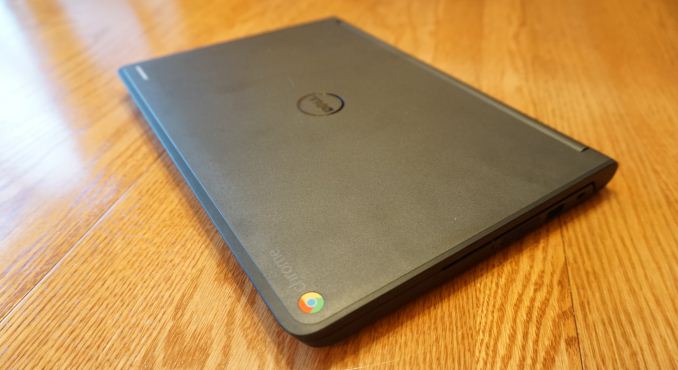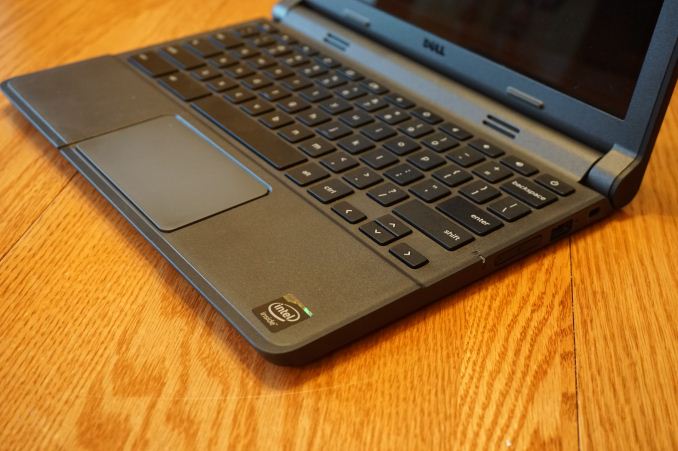The Dell Chromebook 11 Touch Review
by Brandon Chester on May 7, 2015 8:00 AM EST- Posted in
- Laptops
- Chrome OS
- Chromebook
Final Words
As far as Chromebooks go, I think the Dell Chromebook 11 is one of the better devices you can buy without spending $1000 on a Chromebook Pixel. While Intel's Celeron N2840 is more like an Atom chip, it's still perfectly sufficient for the tasks that users will perform on a Chromebook. You can certainly drop even lower in price, with Chromebooks available for $149 and even $99, but you end up making even more hardware sacrifices which significantly compromise the user experience.
Dell has definitely accomplished what they set out to do with the Dell Chromebook 11. It's more than fast enough to run Chrome OS, has an ample amount of RAM to keep your tabs open, and it has the best web browsing battery life of all the Chromebooks and tablets that we've ever tested. It's also very durable and well constructed. While the design isn't exactly stunning, it avoids looking like a bulky brick laptop that you would bring to use in a war zone.
Unfortunately, the Dell Chromebook 11 with the touchscreen faces some serious competition from Toshiba's Chromebook 2. Both of them have roughly the same internal specifications, but the Toshiba has a display that is vastly superior in every respect, without the not very useful touchscreen capabilities. Dell's pursuit of a touchscreen and a highly durable design have forced them to cut costs with the display quality in order to reach their price of $329. For your average user, I really have to give the Toshiba the recommendation over the Dell Chromebook 11 at that price point, as the higher resolution display makes everything sharper and allows much more to be seen on screen than a cramped 1366x768 display. While the Toshiba's battery life is significantly shorter due to the increased display power usage, I still think it's the better option.
Despite my feeling that the Toshiba Chromebook 2 is a better purchase for most users, the Dell Chromebook 11 doesn't lack appeal to certain segments of the market. One of the markets that I believe it will be widely adopted in will be education. While I feared that schools and other academic institutions would simply opt for the most inexpensive Chromebooks possible for budget related reasons, some investigation of the local high school in my area revealed that they already have a large number of Dell Chromebook 11 units in use. Some students don't tend to take care of electronic devices that don't belong to them, and the Dell Chromebook 11 stands up to the abuse and misuse better than other devices.
The other area where the Dell Chromebook 11 will stand above the Toshiba is any environment that isn't electronics friendly. People working in construction or in geographical areas where dust and dirt are unavoidable will definitely benefit from the rugged design and MIL-STD rated resistance to fluids, dust, etc.
There is one final consideration, and that's the non-touch model of the Dell Chromebook 11. Starting at $249 for 2GB of RAM, or $269 for 4GB of RAM, both of these configurations offer a very capable Chromebook for your money. This is actually the model I saw adopted in schools, as the $50 price increase for the addition of a touchscreen is not really worth it with how limited its usefulness is in Chrome OS. Considering that other Chromebooks with similar specifications but less rugged build quality than the Dell Chromebook 11 can also cost this much, it's definitely a Chromebook that should be heavily considered at those price points.
In closing, I'll say that users who need a laptop with the durability of the Dell Chromebook 11 probably won't be considering other Chromebooks in the first place. I highly recommend opting for the non-touch model, as the touchscreen is not very useful and increases the cost significantly. But when considering the touchscreen model my general recommendation for a Chromebook at that price still has to go to the Toshiba Chromebook 2 because of its display. Paying the $50 extra over the base model Toshiba for the 1080p IPS panel is a much better use of your money than the $50 for a touchscreen on the Dell. At $249 or $269 for the non-touch model, I would probably still encourage users to spend the extra bit for the Toshiba. But if the rugged build is necessary, or if someone really needs to keep their budget around $250, then the Dell Chromebook 11 will be their best bet.












46 Comments
View All Comments
Refuge - Monday, May 11, 2015 - link
I just can't take you seriously...Lord of the Bored - Friday, May 8, 2015 - link
A. Yes, Chromebooks can have a more conventional version of Lunix installed on them.B. The high cost for the amount of computer you're getting is because this one's "ruggedized." If you want the most bang for your buck, you don't get an armored computer. But if you want a computer that will take a licking and keep on ticking, you pay the premium.
nandnandnand - Thursday, May 7, 2015 - link
Is that the "Professor" on screen?webdoctors - Thursday, May 7, 2015 - link
This key paragraph should be in bold and giant font:I'm honestly very disappointed with the Dell Chromebook 11's display. I had thought the industry had moved past TN displays, with even the $99 HP Stream 7 sporting an IPS panel. With poor viewing angles, a low resolution of 1366x768, and poor color reproduction, the display on the Dell Chromebook 11 really has no redeeming values. It's especially disappointing when compared to the equivalently priced Toshiba Chromebook 2 which does very well in all of our tests and has a much higher resolution of 1920x1080 on a slightly larger 13.3" panel.
I have the Toshiba Chromebook, and the light weight and amazing screen really make it standout.
SM123456 - Thursday, May 7, 2015 - link
The $99 HP Stream 7 has a 7" screen limited RAM and a much slower processor though, plus if you want, there are Chromebooks with 1080P IPS screens if you want. The 720p 1366x768 screen isn't particularly noticeable, but the TN display with its narrow viewing angles and washed out display is. Still, a lot of people are OK with that and prefer not to pay for a better screen. Sill I guess it is each to his/her own.sorten - Thursday, May 7, 2015 - link
A web browsing machine with an 11" screen with 13x7 resolution. So ... what distinguishes this from the netbook of years past?jabber - Friday, May 8, 2015 - link
Well netbooks had a smaller 1024x600 res screen so there is that.Plus netbooks were really slow.
timgonzales - Friday, May 8, 2015 - link
I had the non-touch, 2GB version of this Chromebook from Amazon for $189.99 (before tax) and had to return it because the display was god awful. My sister-in-law recently bought an HP Stream 11 and, surprisingly, it has a significantly better screen in comparison.zodiacfml - Friday, May 8, 2015 - link
This is just perfect for schools which explains most of the design.You don't know how invaluable the Wi-Fi AC is in a dense classroom. Dual stream adds icing on the cake. 30 of the same device in a classroom should not be a problem for a single Wi-Fi AC router or access point.
The display is pathetic though. This should drop in price around $200 - $250 where you could find Windows 8.1 laptops without the AC standard.
jabber - Friday, May 8, 2015 - link
1366x768 is actually fine on a 11" screen. Anything larger and it's unacceptable.However, if using that res at 11" there is no reason not to spend another $5 on a calibrated IPS spec panel to at least make it look better.
However, I would accept a 1440/1600x900 as a budget 11" option.